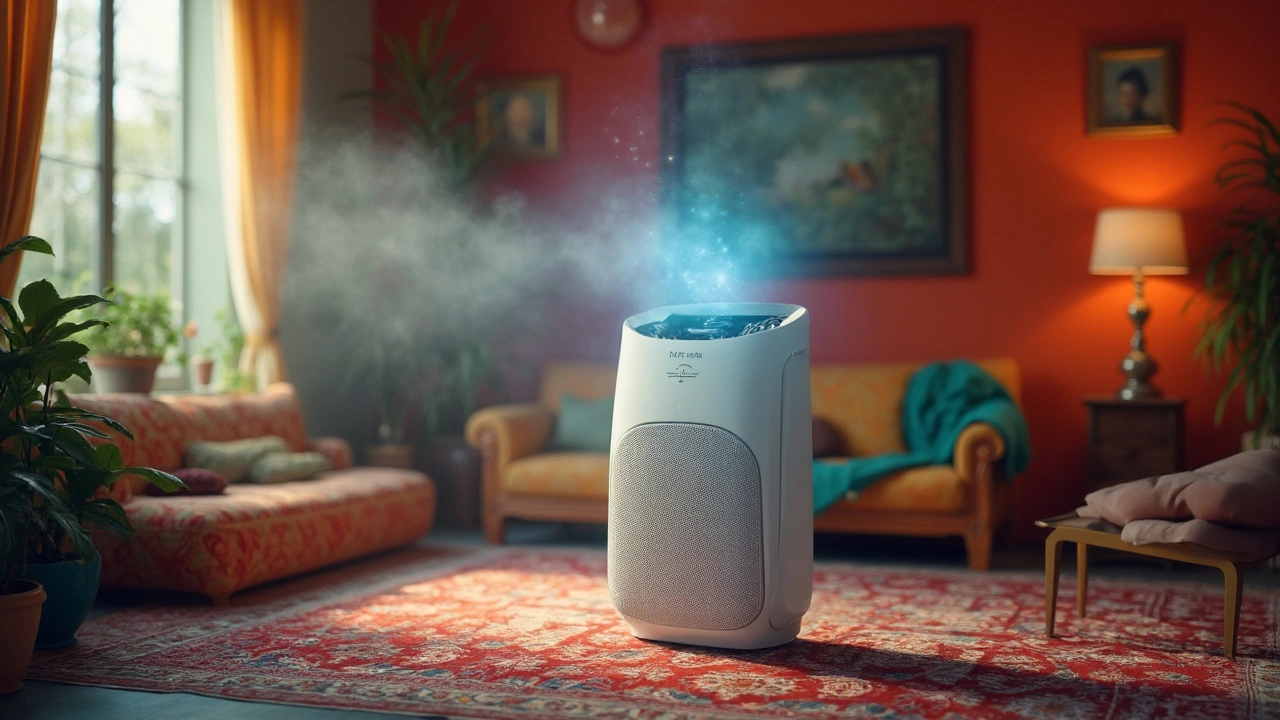
HEPA air purifiers are like the superheroes of the air-cleaning world, zapping away dust, pollen, and other sneaky particles. But even superheroes have their kryptonite. If you're thinking about adding one to your home, you might want to know they aren't all sunshine and fresh air.
First off, not all HEPA purifiers are created equal. While they're generally fantastic at trapping particles, some models can unintentionally produce ozone—a pollutant that could pose health risks if you’re sensitive or have respiratory issues. It's crucial to pick a model that doesn’t emit ozone or to use it properly to keep your home safe.
And let's not forget about noise. Have you ever tried to concentrate with a constant hum in the background? Some air purifiers can be quite loud, making it hard to focus or relax in your own space. So, before you click 'buy,' check those decibel levels to find one that fits your noise tolerance.
Introduction to HEPA Air Purifiers
HEPA, which stands for High-Efficiency Particulate Air, sets a high bar in the world of air filtration. To earn the HEPA label, a filter must trap at least 99.97% of particles that are 0.3 microns in size. This is the size range that scientific research finds most difficult to capture—hence the term 'Most Penetrating Particle Size' (MPPS).
So, what makes these purifiers such a popular choice in homes and offices? They're great at snatching up dust mites, pollen, mold spores, and even some bacterias, helping ease allergies and improve indoor air quality. That’s why they sometimes get the reputation of being a must-have for those who want clean air.
How Do They Work?
Here's the simplified version: as air moves through a HEPA filter, particles stick to the fibers. There are actually several mechanisms at play, including interception, impaction, and diffusion, each catching different sizes of particles.
Choosing the Right One
Now, a quick tip: when you’re shopping for an air purifier, be sure to check that it's a true HEPA filter and not just 'HEPA-like' or 'HEPA-type'. Those cheaper imitators don’t meet the same standards.
| Aspect | Description |
|---|---|
| Efficiency | Traps 99.97% of particles |
| Common Uses | Allergy relief, improved air quality |
| Average Cost | Varies from £50 to £500 |
When you know the basics about how HEPA air purifiers work and what to look out for, you're in a better spot to make the right choice for your home or office space. Trust me, doing a bit of homework pays off in the long run!
Health Concerns
While HEPA air purifiers are mostly hailed for cleaning up the air, there are some health-related hiccups you should be aware of. First and foremost, the issue with ozone. Some air purifiers, especially ones that use ionizing technology, create ozone as they operate. And trust me, inhaling ozone isn't as cool as it sounds. It can irritate your lungs, leading to coughing or chest pain, especially if you have asthma or any similar condition.
But that's not all. There’s also the matter of particle resuspension, which might sound fancy but it's pretty simple. When air purifiers blow out air, they can sometimes stir up settled dust and allergens, especially if the purifier has a strong fan. This means they end up back in the air you breathe. It's like trying to clean up a mess while accidentally creating another one.
Noise Levels and Sleep
Another thing to watch out for is noise, particularly if you plan to use these purifiers in your bedroom. Some of these devices sound like they're gearing up for takeoff. Consistent exposure to that kind of noise can disrupt your sleep or simply become a gnawing annoyance. If you’re a light sleeper, it's a good idea to look for units marketed as 'quiet' or 'whisper' models.
To stay safe, go for HEPA air purifiers that are proven to be ozone-free and check user reviews for noise complaints. Also, consider purifiers with adjustable settings so you don’t have to run them on high all the time. This way, you keep your air clean and your peace of mind intact.

Environmental Impact
Let's talk about something we often overlook—how these HEPA air purifiers affect the environment. While they're busy cleaning your indoor air, they do have some environmental downsides worth considering.
First off, the energy consumption. HEPA purifiers need electricity to run, and depending on the model, they can be quite the energy hogs. If you're using them non-stop to keep your air clean, you're likely bumping up your electricity bill and your carbon footprint at the same time.
Disposal and Waste
Another biggie is the filters themselves. They do a great job capturing those pesky particles, but they don't last forever. You'll find yourself needing to replace them, sometimes as often as every 3 to 6 months. All those used filters can add up to a lot of waste, posing a challenge for environmentally-conscious consumers. What do you do with all those spent filters? Sadly, most of them aren't recyclable.
Ozone and Other Byproducts
Surprisingly, some models might do more harm than good. Did you know certain air purifiers might release ozone as a byproduct? This is a bit of a sticky point for environmentalists since ozone at ground level is a pollutant that can contribute to smog problems. If you're trying to minimize pollution, make sure to opt for HEPA air purifiers that don’t emit ozone or any other harmful byproducts.
In fact, here's a quick tip to help: Look for purifiers with the certification 'ozone-free' to avoid this issue altogether.
Now, consider the bigger picture. While air purifiers can seriously help reduce indoor allergens and pollutants, choosing an efficient model and using it wisely can make all the difference. Finding one that balances energy use and cleaning power will not only help the planet but also give your electric meter a much-needed break.
Practical Tips for Users
So, you've decided to integrate a HEPA air purifier into your home. Smart move! But to get the most out of it, there are a few practical tips you should keep in mind.
1. Placement Matters
Where you place your air purifier can make a huge difference. Aim for an open area where air can circulate freely. Avoid corners or spaces too close to walls. Placing them in your bedroom or living area typically offers the best results, especially where you spend most of your time indoors.
2. Maintenance is Key
Don't let your purifier go dusty! Regular maintenance is crucial. Check the manufacturer's guide, but generally, changing filters every 6-12 months keeps your device running smoothly. A clogged filter won't purify your air effectively and can become a breeding ground for allergens.
3. Monitor Air Quality
While a purifier helps, consider getting an air quality monitor. It provides insight into the freshness of your air and helps you adjust settings for your purifier accordingly. Some advanced purifiers even have built-in sensors—definitely a plus!
4. Mindful of Ozone Levels
Some air purifiers, particularly those with ionizers, can produce ozone. Check product specs and opt for models specifically marked as 'low or zero ozone' during operation to keep your home's air healthy.
5. Energy Consumption
Concerns about your energy bill? Look for purifiers with an Energy Star rating. They tend to use less power, saving some cash while ensuring clean air.
In summary, getting the best results from a HEPA air purifier relies on proper use and upkeep. Keep these tips in mind, and your air should stay fresh, helping you breathe easy.